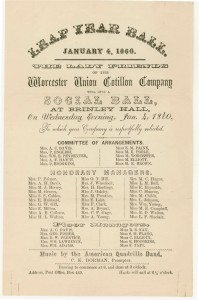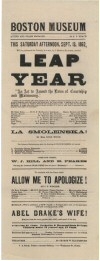Here in New England, we are often glad that February is the shortest month, even in a leap year. Back in 45 B.C., the Julian calendar codified the tradition of adding a day to February every four years, and the Gregorian calendar followed suit. The practice, of course, continues today and helps align the seasons and planetary rotation with our calendars. In nineteenth-century America, leap year was often used as excuse for winter parties and balls. The British tradition of allowing women to propose m arriage during a leap year was adopted in the United States and resulted in many jokes and stories in the local papers, played out in the theater, and in children’s books.
arriage during a leap year was adopted in the United States and resulted in many jokes and stories in the local papers, played out in the theater, and in children’s books.
To mark February 29, 2012, we selected a few items from the collection to display in our Reading Room. For those of you who can not make it to Worcester in February, this post will have to substitute. The two invitations to Leap Year parties date from the 1860s, with one featuring a quadrille band and dancing until 3:00am. The play Leap Year is a comical farce published around 1860, and was performed in Boston in 1862 as shown in the broadside playbill. The 1872 McLoughlin publication, although part of the Society’s children’s literature collection, was likely intended for an adult audience. The humorous illustrations feature all sorts of unmarried women seeking marriageable men in banks, taverns and on the street.

A search in the American Historical Newspaper database resulted in hundreds of articles and essays in January and February issues of leap years, often satirizing unmarried women and bachelors. An article in an 1804 issue of the Dover, New Hampshire Sun states:
It has from time immemorial been considered a rightful prerogative of the ladies in LEAP YEAR, without subjecting themselves to any imputation or want of modesty, to make the first advances in negotiations for matrimonial alliances.
An 1820 headline reads “Old Bachelors, Look Out!” and a mock “Bachelor’s petition” appeared in The American Citizen from Jackson, Michigan in 1852, encouraging “unmarried ladies of all kinds, sizes, and ages” to propose because most bachelors were really just shy and would make good husbands.
All of this raises interesting questions about gender roles, marriage, and American society — especially after 1860, when eligible, unmarried men were in extremely short supply due to the Civil War. The war resulted in over 600,000 male deaths in this country, knocking social mores on their heels. It is all well and good to make fun and joke, but it is very likely that for a few leap years (1864, 1868, 1872, 1876), women took advantage of the relaxation of the rules and proposed to those men that could help them build a family and a future in the healing nation.
